Safeguarding Vulnerable People: Health and Social Care Case Study
VerifiedAdded on 2023/06/13
|12
|3529
|245
Report
AI Summary
This report examines the critical issue of safeguarding vulnerable people within the health and social care sector, with a specific focus on the Mid Staffordshire NHS Foundation Trust Hospital case. It defines vulnerability, identifies vulnerable groups such as children, the elderly, and individuals with disabilities, and explores various forms of abuse including physical, mental, financial, and cultural abuse. The report highlights the systemic failures at Mid Staffordshire Hospital, including staff negligence, poor care processes, and instances of patient abuse, leading to significant emotional and physical harm. It further discusses the impact of abuse on vulnerable individuals, including mental health issues, trauma, and developmental delays, emphasizing the importance of safeguarding policies and ethical care practices to protect these at-risk populations. Desklib offers a wealth of resources, including past papers and solved assignments, to support students in their understanding of this vital area.
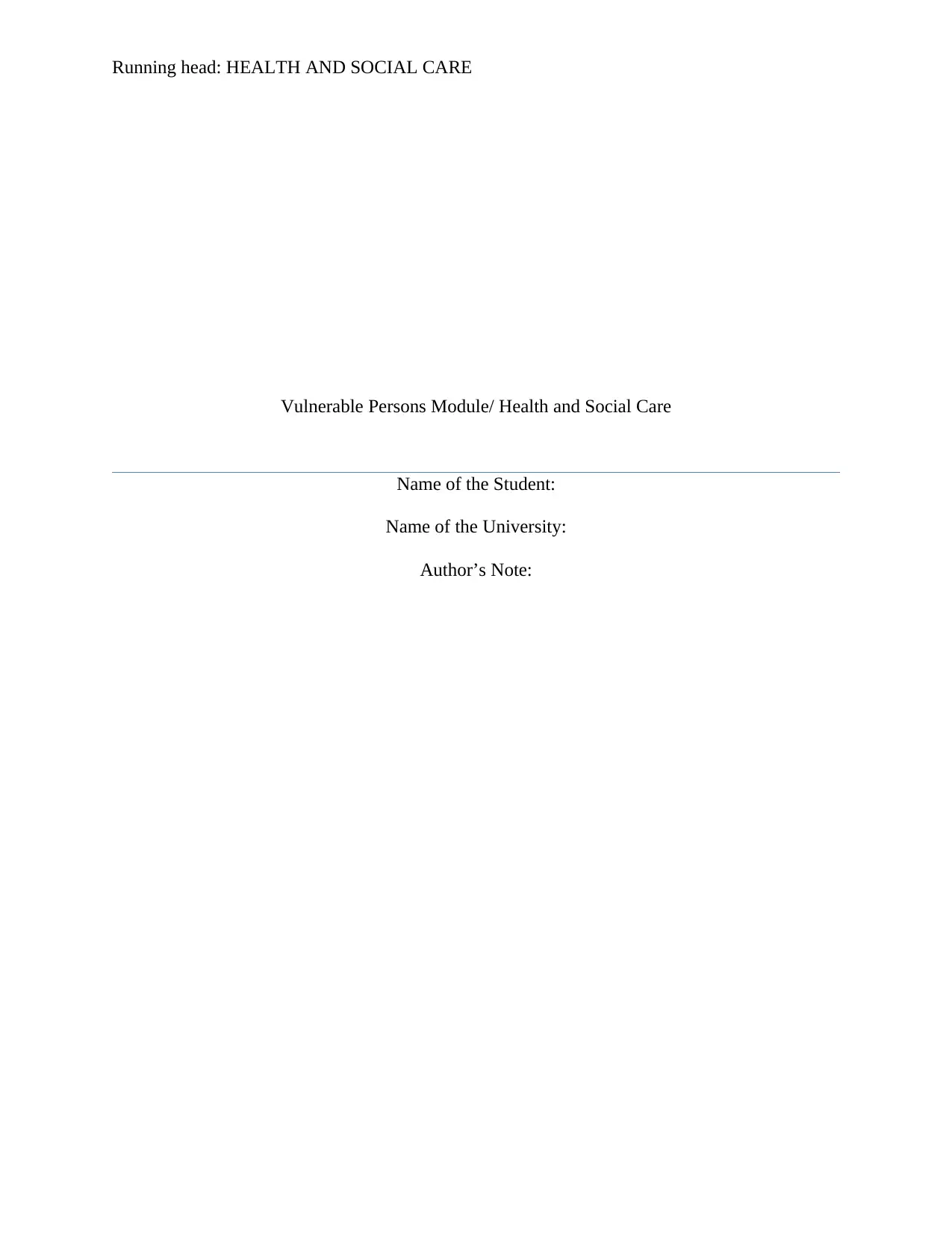
Running head: HEALTH AND SOCIAL CARE
Vulnerable Persons Module/ Health and Social Care
Name of the Student:
Name of the University:
Author’s Note:
Vulnerable Persons Module/ Health and Social Care
Name of the Student:
Name of the University:
Author’s Note:
Paraphrase This Document
Need a fresh take? Get an instant paraphrase of this document with our AI Paraphraser
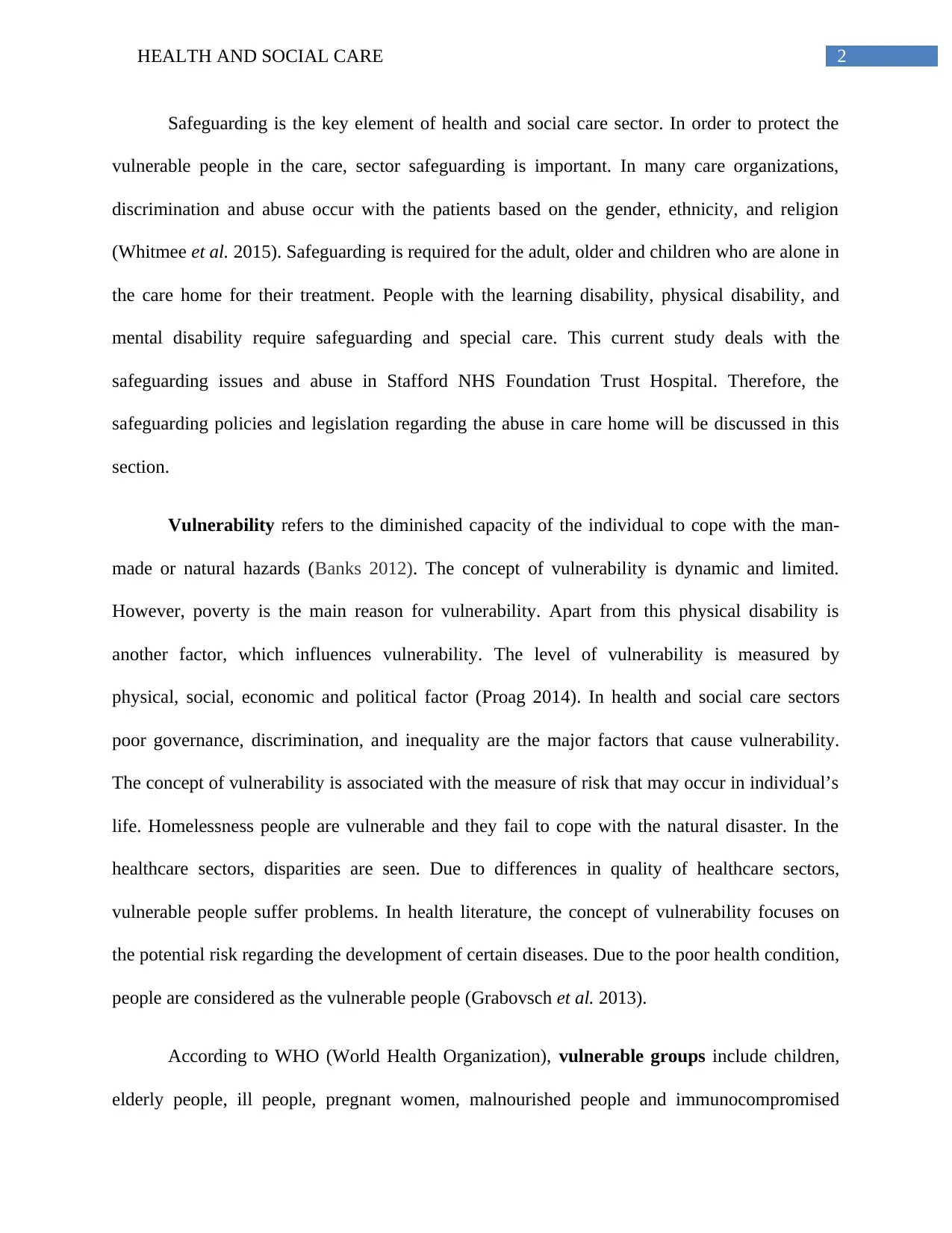
2HEALTH AND SOCIAL CARE
Safeguarding is the key element of health and social care sector. In order to protect the
vulnerable people in the care, sector safeguarding is important. In many care organizations,
discrimination and abuse occur with the patients based on the gender, ethnicity, and religion
(Whitmee et al. 2015). Safeguarding is required for the adult, older and children who are alone in
the care home for their treatment. People with the learning disability, physical disability, and
mental disability require safeguarding and special care. This current study deals with the
safeguarding issues and abuse in Stafford NHS Foundation Trust Hospital. Therefore, the
safeguarding policies and legislation regarding the abuse in care home will be discussed in this
section.
Vulnerability refers to the diminished capacity of the individual to cope with the man-
made or natural hazards (Banks 2012). The concept of vulnerability is dynamic and limited.
However, poverty is the main reason for vulnerability. Apart from this physical disability is
another factor, which influences vulnerability. The level of vulnerability is measured by
physical, social, economic and political factor (Proag 2014). In health and social care sectors
poor governance, discrimination, and inequality are the major factors that cause vulnerability.
The concept of vulnerability is associated with the measure of risk that may occur in individual’s
life. Homelessness people are vulnerable and they fail to cope with the natural disaster. In the
healthcare sectors, disparities are seen. Due to differences in quality of healthcare sectors,
vulnerable people suffer problems. In health literature, the concept of vulnerability focuses on
the potential risk regarding the development of certain diseases. Due to the poor health condition,
people are considered as the vulnerable people (Grabovsch et al. 2013).
According to WHO (World Health Organization), vulnerable groups include children,
elderly people, ill people, pregnant women, malnourished people and immunocompromised
Safeguarding is the key element of health and social care sector. In order to protect the
vulnerable people in the care, sector safeguarding is important. In many care organizations,
discrimination and abuse occur with the patients based on the gender, ethnicity, and religion
(Whitmee et al. 2015). Safeguarding is required for the adult, older and children who are alone in
the care home for their treatment. People with the learning disability, physical disability, and
mental disability require safeguarding and special care. This current study deals with the
safeguarding issues and abuse in Stafford NHS Foundation Trust Hospital. Therefore, the
safeguarding policies and legislation regarding the abuse in care home will be discussed in this
section.
Vulnerability refers to the diminished capacity of the individual to cope with the man-
made or natural hazards (Banks 2012). The concept of vulnerability is dynamic and limited.
However, poverty is the main reason for vulnerability. Apart from this physical disability is
another factor, which influences vulnerability. The level of vulnerability is measured by
physical, social, economic and political factor (Proag 2014). In health and social care sectors
poor governance, discrimination, and inequality are the major factors that cause vulnerability.
The concept of vulnerability is associated with the measure of risk that may occur in individual’s
life. Homelessness people are vulnerable and they fail to cope with the natural disaster. In the
healthcare sectors, disparities are seen. Due to differences in quality of healthcare sectors,
vulnerable people suffer problems. In health literature, the concept of vulnerability focuses on
the potential risk regarding the development of certain diseases. Due to the poor health condition,
people are considered as the vulnerable people (Grabovsch et al. 2013).
According to WHO (World Health Organization), vulnerable groups include children,
elderly people, ill people, pregnant women, malnourished people and immunocompromised
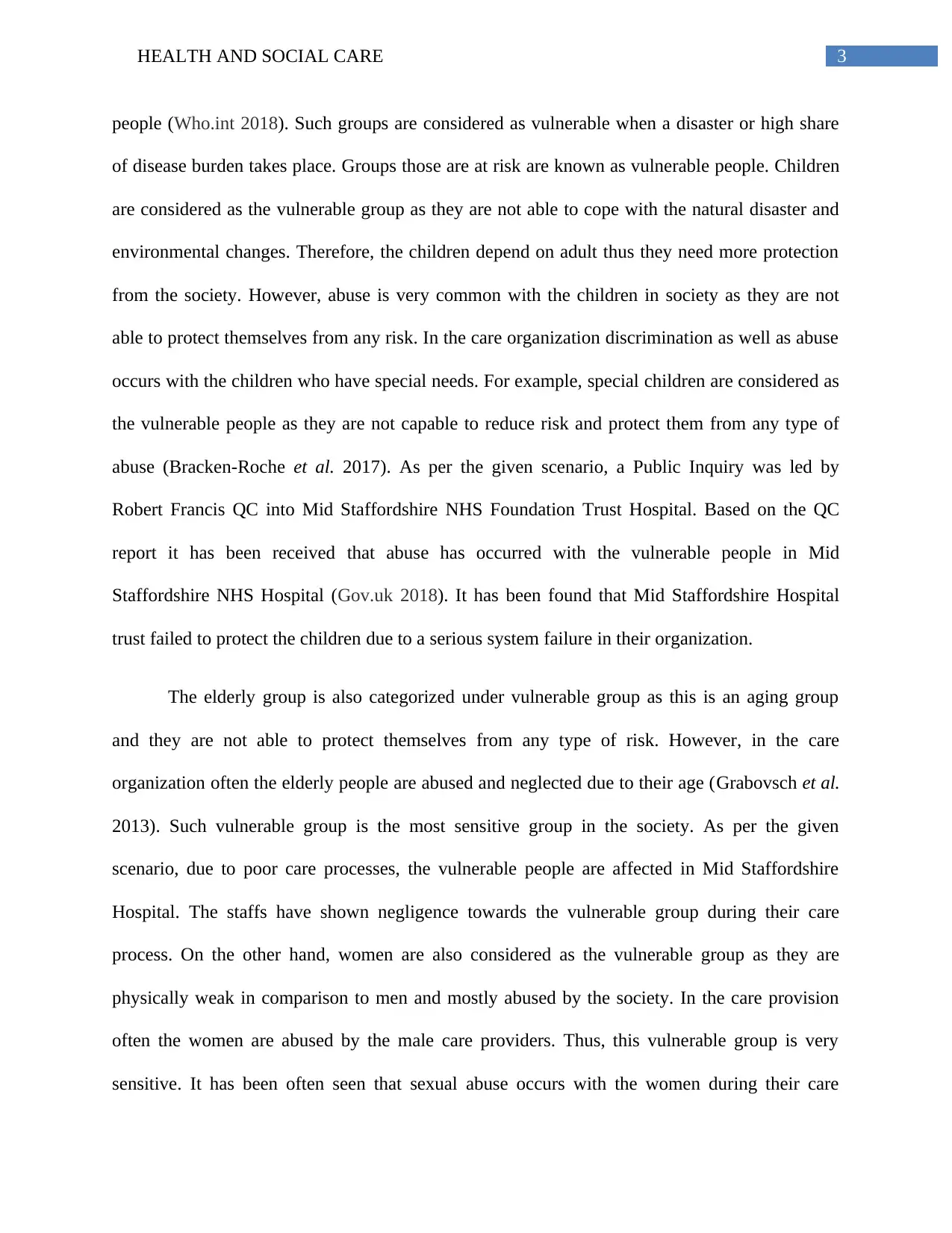
3HEALTH AND SOCIAL CARE
people (Who.int 2018). Such groups are considered as vulnerable when a disaster or high share
of disease burden takes place. Groups those are at risk are known as vulnerable people. Children
are considered as the vulnerable group as they are not able to cope with the natural disaster and
environmental changes. Therefore, the children depend on adult thus they need more protection
from the society. However, abuse is very common with the children in society as they are not
able to protect themselves from any risk. In the care organization discrimination as well as abuse
occurs with the children who have special needs. For example, special children are considered as
the vulnerable people as they are not capable to reduce risk and protect them from any type of
abuse (Bracken-Roche et al. 2017). As per the given scenario, a Public Inquiry was led by
Robert Francis QC into Mid Staffordshire NHS Foundation Trust Hospital. Based on the QC
report it has been received that abuse has occurred with the vulnerable people in Mid
Staffordshire NHS Hospital (Gov.uk 2018). It has been found that Mid Staffordshire Hospital
trust failed to protect the children due to a serious system failure in their organization.
The elderly group is also categorized under vulnerable group as this is an aging group
and they are not able to protect themselves from any type of risk. However, in the care
organization often the elderly people are abused and neglected due to their age (Grabovsch et al.
2013). Such vulnerable group is the most sensitive group in the society. As per the given
scenario, due to poor care processes, the vulnerable people are affected in Mid Staffordshire
Hospital. The staffs have shown negligence towards the vulnerable group during their care
process. On the other hand, women are also considered as the vulnerable group as they are
physically weak in comparison to men and mostly abused by the society. In the care provision
often the women are abused by the male care providers. Thus, this vulnerable group is very
sensitive. It has been often seen that sexual abuse occurs with the women during their care
people (Who.int 2018). Such groups are considered as vulnerable when a disaster or high share
of disease burden takes place. Groups those are at risk are known as vulnerable people. Children
are considered as the vulnerable group as they are not able to cope with the natural disaster and
environmental changes. Therefore, the children depend on adult thus they need more protection
from the society. However, abuse is very common with the children in society as they are not
able to protect themselves from any risk. In the care organization discrimination as well as abuse
occurs with the children who have special needs. For example, special children are considered as
the vulnerable people as they are not capable to reduce risk and protect them from any type of
abuse (Bracken-Roche et al. 2017). As per the given scenario, a Public Inquiry was led by
Robert Francis QC into Mid Staffordshire NHS Foundation Trust Hospital. Based on the QC
report it has been received that abuse has occurred with the vulnerable people in Mid
Staffordshire NHS Hospital (Gov.uk 2018). It has been found that Mid Staffordshire Hospital
trust failed to protect the children due to a serious system failure in their organization.
The elderly group is also categorized under vulnerable group as this is an aging group
and they are not able to protect themselves from any type of risk. However, in the care
organization often the elderly people are abused and neglected due to their age (Grabovsch et al.
2013). Such vulnerable group is the most sensitive group in the society. As per the given
scenario, due to poor care processes, the vulnerable people are affected in Mid Staffordshire
Hospital. The staffs have shown negligence towards the vulnerable group during their care
process. On the other hand, women are also considered as the vulnerable group as they are
physically weak in comparison to men and mostly abused by the society. In the care provision
often the women are abused by the male care providers. Thus, this vulnerable group is very
sensitive. It has been often seen that sexual abuse occurs with the women during their care
⊘ This is a preview!⊘
Do you want full access?
Subscribe today to unlock all pages.

Trusted by 1+ million students worldwide

4HEALTH AND SOCIAL CARE
process. This is a big risk for such vulnerable group in the society. For this reason, protection is
required for the women during their care process. Apart from this adult and elderly people those
have physical disabilities are considered as the vulnerable group. Such people are often neglected
due to their health inequalities in the society. On the other hand, people with mental disorder are
often abused in care organization. From the above analysis, it can be evaluated that women,
children, elderly people and individuals with health issues are major vulnerable groups in the
society. In the Mid Staffordshire NHS Foundations abuse occurred with the elderly patients by
giving wrong medication and children did not get proper care and they are admitted for a long
time in this hospital (Birminghampost.co.uk 2018). This type of abuse occurred in this hospital
with vulnerable groups, which affected the image of this organization.
Abuse is categorized into different forms. Different types of abuse include physical
abuse, mental abuse, financial abuse, verbal abuse, cultural abuse and sexual abuse. Physical
abuse focuses on the hitting the individuals. Often vulnerable people are physically abused by
others. As for example, the elderly people and the children are often physically abused by others
as they are not capable enough to protect them. Sexual abuse is another type of abuse that
generally occurs with the women in society. This type of abuse is also one type of physical abuse
(Plantz and Garbarino 2017). In the care organization often the male service providers abuse
female patients by harassing them sexually. This is a big drawback of society and the care
provision. On the other hand, often the patients in a care organization are emotionally abused by
the hospital staffs. Financial abuse is very common in the care organization. Often the hospital
staffs financially abuse the patients by taking the high cost from then against their treatment
(Kim et al. 2017). This is a major drawback of the society due to lack of protection for the
process. This is a big risk for such vulnerable group in the society. For this reason, protection is
required for the women during their care process. Apart from this adult and elderly people those
have physical disabilities are considered as the vulnerable group. Such people are often neglected
due to their health inequalities in the society. On the other hand, people with mental disorder are
often abused in care organization. From the above analysis, it can be evaluated that women,
children, elderly people and individuals with health issues are major vulnerable groups in the
society. In the Mid Staffordshire NHS Foundations abuse occurred with the elderly patients by
giving wrong medication and children did not get proper care and they are admitted for a long
time in this hospital (Birminghampost.co.uk 2018). This type of abuse occurred in this hospital
with vulnerable groups, which affected the image of this organization.
Abuse is categorized into different forms. Different types of abuse include physical
abuse, mental abuse, financial abuse, verbal abuse, cultural abuse and sexual abuse. Physical
abuse focuses on the hitting the individuals. Often vulnerable people are physically abused by
others. As for example, the elderly people and the children are often physically abused by others
as they are not capable enough to protect them. Sexual abuse is another type of abuse that
generally occurs with the women in society. This type of abuse is also one type of physical abuse
(Plantz and Garbarino 2017). In the care organization often the male service providers abuse
female patients by harassing them sexually. This is a big drawback of society and the care
provision. On the other hand, often the patients in a care organization are emotionally abused by
the hospital staffs. Financial abuse is very common in the care organization. Often the hospital
staffs financially abuse the patients by taking the high cost from then against their treatment
(Kim et al. 2017). This is a major drawback of the society due to lack of protection for the
Paraphrase This Document
Need a fresh take? Get an instant paraphrase of this document with our AI Paraphraser

5HEALTH AND SOCIAL CARE
vulnerable people. On the other hand, cultural abuse is very common that often occurs with the
vulnerable people in society and the healthcare sector.
Often the staffs in the healthcare sectors cause gender discrimination and racism with the
patients. This results in the poor quality service. In Mid Staffordshire Hospital poor quality
service is one of the major reasons that lead the patients to be abused. As per the QC report the
staffs often discriminated the patients based on the culture and religion as a result, the individuals
did not get equal care from the care organization, which affects the brand image of the
organization. Mental abuse is another severe type of abuse that occurs in the care organization.
However, often the patients face mental pressure during their care process due to inequality in
the care process. As per the QC report of Mid Staffordshire NHS hospital, it has been received
that shortage of staff and failure of the system is the major drawback of the care process in this
organization (Theguardian.com 2018). This organization did not recruit temporary staffs as this
process is too expensive. On the other hand, there was a serious failure in the care system due to
the staff negligence. The staffs of Mid Staffordshire NHS Hospital humiliate and neglect the
patients during their pain. This caused mental abuse with the patients. It has been analyzed from
the QC report that Mid Staffordshire Hospital is blamed for their poor quality service and patient
abuse.
As per the QC inquiry report regarding Mid Staffordshire Hospital the patients are not
happy with the care process. This report shows that the patients are left in sheets soiled with
urine for long period of time. There is evidence regarding the incidence of falls, which is
suffered by the patients. This led the patients to face serious injury (Theguardian.com 2018). On
the other hand, the nursing staffs did not show good behavior with the vulnerable patients and
gave poor care to the patients. The care process was insufficient and the staffs did not show
vulnerable people. On the other hand, cultural abuse is very common that often occurs with the
vulnerable people in society and the healthcare sector.
Often the staffs in the healthcare sectors cause gender discrimination and racism with the
patients. This results in the poor quality service. In Mid Staffordshire Hospital poor quality
service is one of the major reasons that lead the patients to be abused. As per the QC report the
staffs often discriminated the patients based on the culture and religion as a result, the individuals
did not get equal care from the care organization, which affects the brand image of the
organization. Mental abuse is another severe type of abuse that occurs in the care organization.
However, often the patients face mental pressure during their care process due to inequality in
the care process. As per the QC report of Mid Staffordshire NHS hospital, it has been received
that shortage of staff and failure of the system is the major drawback of the care process in this
organization (Theguardian.com 2018). This organization did not recruit temporary staffs as this
process is too expensive. On the other hand, there was a serious failure in the care system due to
the staff negligence. The staffs of Mid Staffordshire NHS Hospital humiliate and neglect the
patients during their pain. This caused mental abuse with the patients. It has been analyzed from
the QC report that Mid Staffordshire Hospital is blamed for their poor quality service and patient
abuse.
As per the QC inquiry report regarding Mid Staffordshire Hospital the patients are not
happy with the care process. This report shows that the patients are left in sheets soiled with
urine for long period of time. There is evidence regarding the incidence of falls, which is
suffered by the patients. This led the patients to face serious injury (Theguardian.com 2018). On
the other hand, the nursing staffs did not show good behavior with the vulnerable patients and
gave poor care to the patients. The care process was insufficient and the staffs did not show
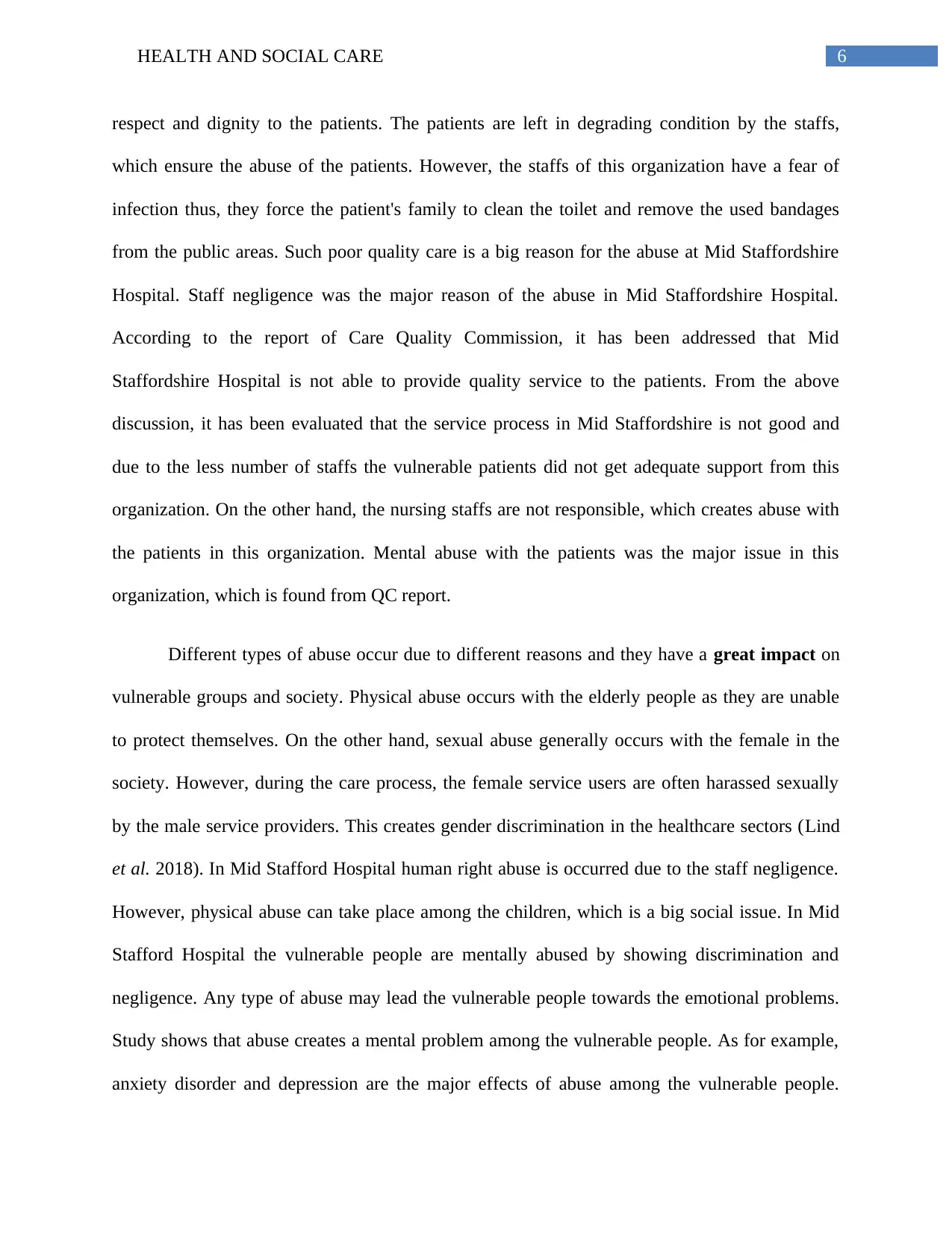
6HEALTH AND SOCIAL CARE
respect and dignity to the patients. The patients are left in degrading condition by the staffs,
which ensure the abuse of the patients. However, the staffs of this organization have a fear of
infection thus, they force the patient's family to clean the toilet and remove the used bandages
from the public areas. Such poor quality care is a big reason for the abuse at Mid Staffordshire
Hospital. Staff negligence was the major reason of the abuse in Mid Staffordshire Hospital.
According to the report of Care Quality Commission, it has been addressed that Mid
Staffordshire Hospital is not able to provide quality service to the patients. From the above
discussion, it has been evaluated that the service process in Mid Staffordshire is not good and
due to the less number of staffs the vulnerable patients did not get adequate support from this
organization. On the other hand, the nursing staffs are not responsible, which creates abuse with
the patients in this organization. Mental abuse with the patients was the major issue in this
organization, which is found from QC report.
Different types of abuse occur due to different reasons and they have a great impact on
vulnerable groups and society. Physical abuse occurs with the elderly people as they are unable
to protect themselves. On the other hand, sexual abuse generally occurs with the female in the
society. However, during the care process, the female service users are often harassed sexually
by the male service providers. This creates gender discrimination in the healthcare sectors (Lind
et al. 2018). In Mid Stafford Hospital human right abuse is occurred due to the staff negligence.
However, physical abuse can take place among the children, which is a big social issue. In Mid
Stafford Hospital the vulnerable people are mentally abused by showing discrimination and
negligence. Any type of abuse may lead the vulnerable people towards the emotional problems.
Study shows that abuse creates a mental problem among the vulnerable people. As for example,
anxiety disorder and depression are the major effects of abuse among the vulnerable people.
respect and dignity to the patients. The patients are left in degrading condition by the staffs,
which ensure the abuse of the patients. However, the staffs of this organization have a fear of
infection thus, they force the patient's family to clean the toilet and remove the used bandages
from the public areas. Such poor quality care is a big reason for the abuse at Mid Staffordshire
Hospital. Staff negligence was the major reason of the abuse in Mid Staffordshire Hospital.
According to the report of Care Quality Commission, it has been addressed that Mid
Staffordshire Hospital is not able to provide quality service to the patients. From the above
discussion, it has been evaluated that the service process in Mid Staffordshire is not good and
due to the less number of staffs the vulnerable patients did not get adequate support from this
organization. On the other hand, the nursing staffs are not responsible, which creates abuse with
the patients in this organization. Mental abuse with the patients was the major issue in this
organization, which is found from QC report.
Different types of abuse occur due to different reasons and they have a great impact on
vulnerable groups and society. Physical abuse occurs with the elderly people as they are unable
to protect themselves. On the other hand, sexual abuse generally occurs with the female in the
society. However, during the care process, the female service users are often harassed sexually
by the male service providers. This creates gender discrimination in the healthcare sectors (Lind
et al. 2018). In Mid Stafford Hospital human right abuse is occurred due to the staff negligence.
However, physical abuse can take place among the children, which is a big social issue. In Mid
Stafford Hospital the vulnerable people are mentally abused by showing discrimination and
negligence. Any type of abuse may lead the vulnerable people towards the emotional problems.
Study shows that abuse creates a mental problem among the vulnerable people. As for example,
anxiety disorder and depression are the major effects of abuse among the vulnerable people.
⊘ This is a preview!⊘
Do you want full access?
Subscribe today to unlock all pages.

Trusted by 1+ million students worldwide
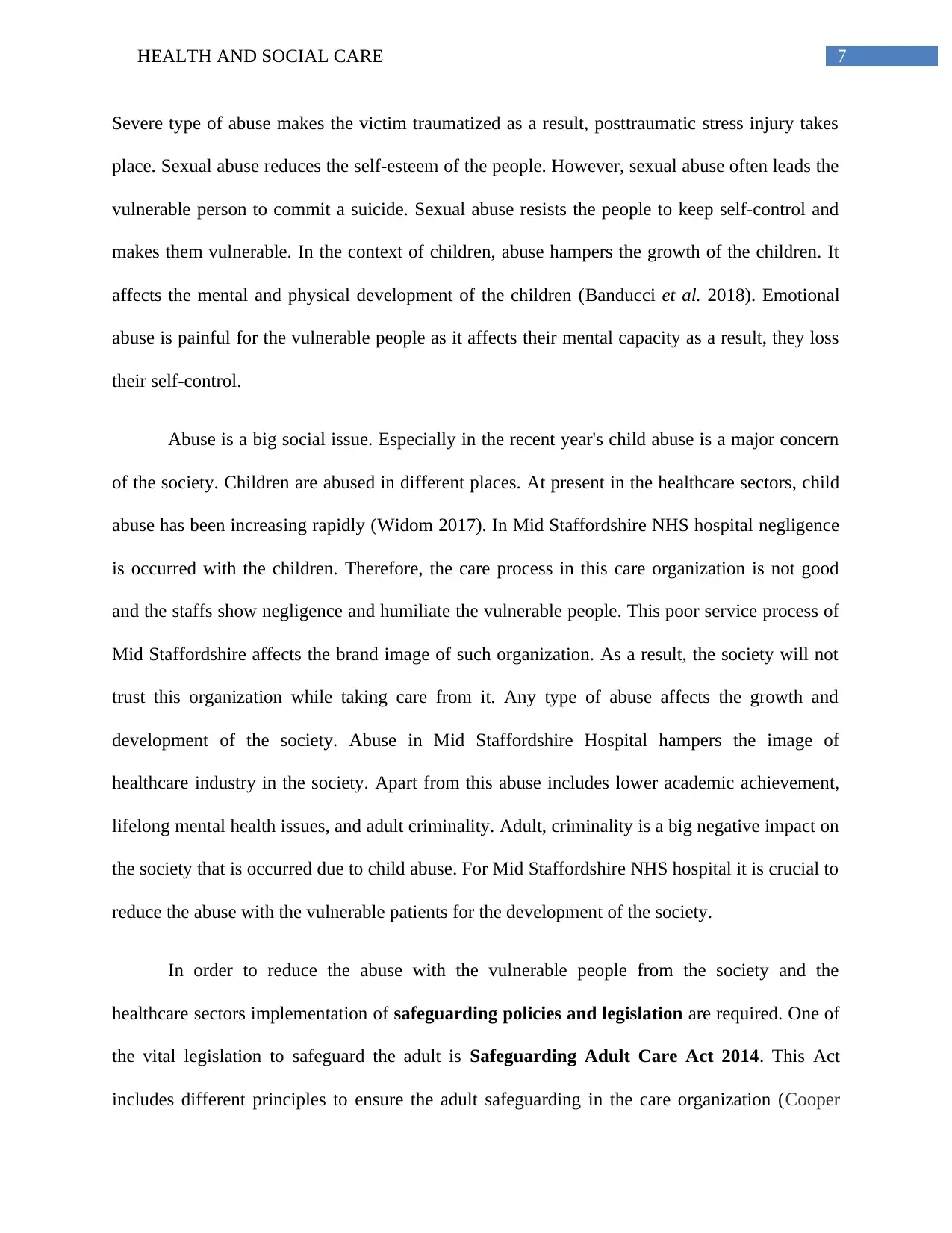
7HEALTH AND SOCIAL CARE
Severe type of abuse makes the victim traumatized as a result, posttraumatic stress injury takes
place. Sexual abuse reduces the self-esteem of the people. However, sexual abuse often leads the
vulnerable person to commit a suicide. Sexual abuse resists the people to keep self-control and
makes them vulnerable. In the context of children, abuse hampers the growth of the children. It
affects the mental and physical development of the children (Banducci et al. 2018). Emotional
abuse is painful for the vulnerable people as it affects their mental capacity as a result, they loss
their self-control.
Abuse is a big social issue. Especially in the recent year's child abuse is a major concern
of the society. Children are abused in different places. At present in the healthcare sectors, child
abuse has been increasing rapidly (Widom 2017). In Mid Staffordshire NHS hospital negligence
is occurred with the children. Therefore, the care process in this care organization is not good
and the staffs show negligence and humiliate the vulnerable people. This poor service process of
Mid Staffordshire affects the brand image of such organization. As a result, the society will not
trust this organization while taking care from it. Any type of abuse affects the growth and
development of the society. Abuse in Mid Staffordshire Hospital hampers the image of
healthcare industry in the society. Apart from this abuse includes lower academic achievement,
lifelong mental health issues, and adult criminality. Adult, criminality is a big negative impact on
the society that is occurred due to child abuse. For Mid Staffordshire NHS hospital it is crucial to
reduce the abuse with the vulnerable patients for the development of the society.
In order to reduce the abuse with the vulnerable people from the society and the
healthcare sectors implementation of safeguarding policies and legislation are required. One of
the vital legislation to safeguard the adult is Safeguarding Adult Care Act 2014. This Act
includes different principles to ensure the adult safeguarding in the care organization (Cooper
Severe type of abuse makes the victim traumatized as a result, posttraumatic stress injury takes
place. Sexual abuse reduces the self-esteem of the people. However, sexual abuse often leads the
vulnerable person to commit a suicide. Sexual abuse resists the people to keep self-control and
makes them vulnerable. In the context of children, abuse hampers the growth of the children. It
affects the mental and physical development of the children (Banducci et al. 2018). Emotional
abuse is painful for the vulnerable people as it affects their mental capacity as a result, they loss
their self-control.
Abuse is a big social issue. Especially in the recent year's child abuse is a major concern
of the society. Children are abused in different places. At present in the healthcare sectors, child
abuse has been increasing rapidly (Widom 2017). In Mid Staffordshire NHS hospital negligence
is occurred with the children. Therefore, the care process in this care organization is not good
and the staffs show negligence and humiliate the vulnerable people. This poor service process of
Mid Staffordshire affects the brand image of such organization. As a result, the society will not
trust this organization while taking care from it. Any type of abuse affects the growth and
development of the society. Abuse in Mid Staffordshire Hospital hampers the image of
healthcare industry in the society. Apart from this abuse includes lower academic achievement,
lifelong mental health issues, and adult criminality. Adult, criminality is a big negative impact on
the society that is occurred due to child abuse. For Mid Staffordshire NHS hospital it is crucial to
reduce the abuse with the vulnerable patients for the development of the society.
In order to reduce the abuse with the vulnerable people from the society and the
healthcare sectors implementation of safeguarding policies and legislation are required. One of
the vital legislation to safeguard the adult is Safeguarding Adult Care Act 2014. This Act
includes different principles to ensure the adult safeguarding in the care organization (Cooper
Paraphrase This Document
Need a fresh take? Get an instant paraphrase of this document with our AI Paraphraser
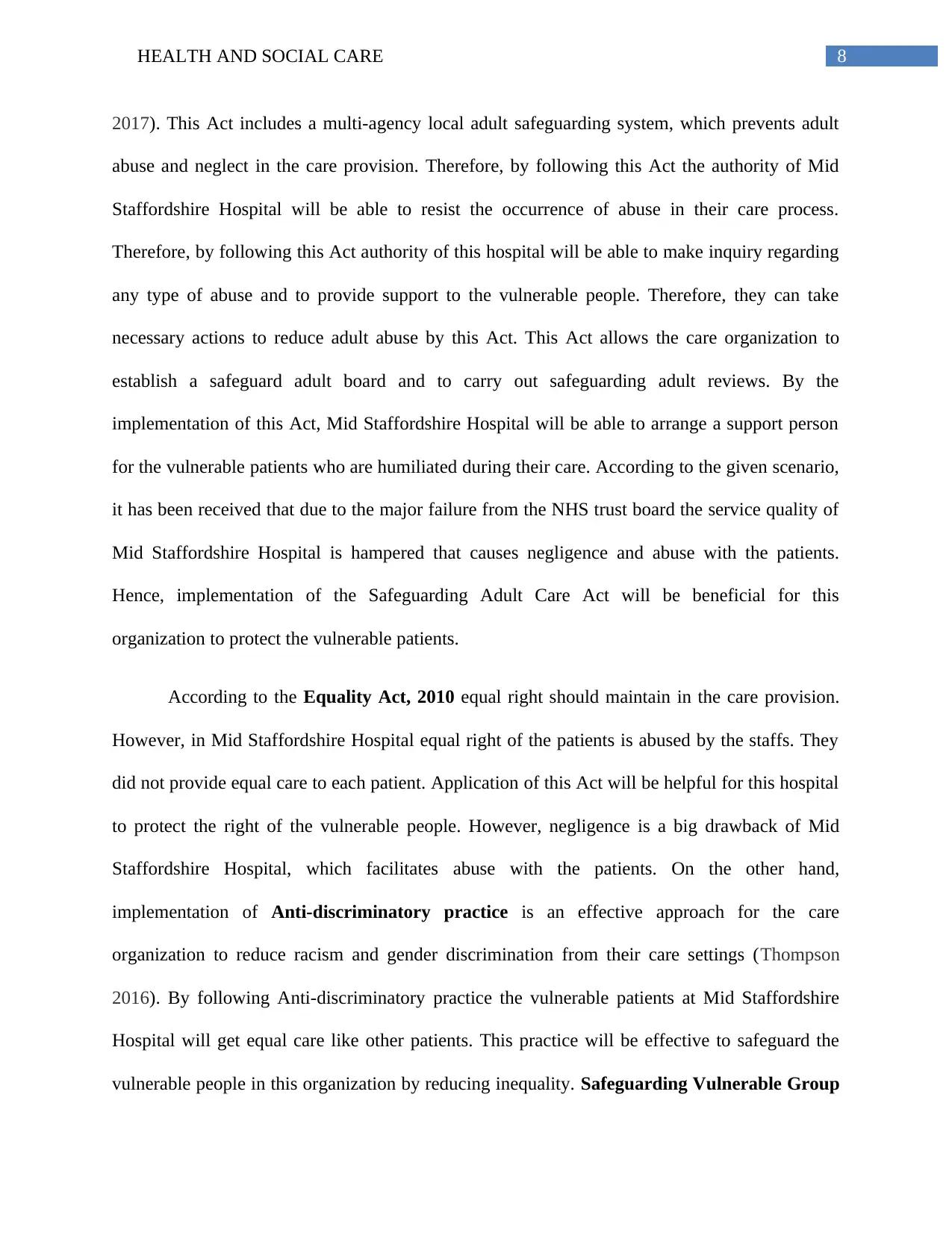
8HEALTH AND SOCIAL CARE
2017). This Act includes a multi-agency local adult safeguarding system, which prevents adult
abuse and neglect in the care provision. Therefore, by following this Act the authority of Mid
Staffordshire Hospital will be able to resist the occurrence of abuse in their care process.
Therefore, by following this Act authority of this hospital will be able to make inquiry regarding
any type of abuse and to provide support to the vulnerable people. Therefore, they can take
necessary actions to reduce adult abuse by this Act. This Act allows the care organization to
establish a safeguard adult board and to carry out safeguarding adult reviews. By the
implementation of this Act, Mid Staffordshire Hospital will be able to arrange a support person
for the vulnerable patients who are humiliated during their care. According to the given scenario,
it has been received that due to the major failure from the NHS trust board the service quality of
Mid Staffordshire Hospital is hampered that causes negligence and abuse with the patients.
Hence, implementation of the Safeguarding Adult Care Act will be beneficial for this
organization to protect the vulnerable patients.
According to the Equality Act, 2010 equal right should maintain in the care provision.
However, in Mid Staffordshire Hospital equal right of the patients is abused by the staffs. They
did not provide equal care to each patient. Application of this Act will be helpful for this hospital
to protect the right of the vulnerable people. However, negligence is a big drawback of Mid
Staffordshire Hospital, which facilitates abuse with the patients. On the other hand,
implementation of Anti-discriminatory practice is an effective approach for the care
organization to reduce racism and gender discrimination from their care settings (Thompson
2016). By following Anti-discriminatory practice the vulnerable patients at Mid Staffordshire
Hospital will get equal care like other patients. This practice will be effective to safeguard the
vulnerable people in this organization by reducing inequality. Safeguarding Vulnerable Group
2017). This Act includes a multi-agency local adult safeguarding system, which prevents adult
abuse and neglect in the care provision. Therefore, by following this Act the authority of Mid
Staffordshire Hospital will be able to resist the occurrence of abuse in their care process.
Therefore, by following this Act authority of this hospital will be able to make inquiry regarding
any type of abuse and to provide support to the vulnerable people. Therefore, they can take
necessary actions to reduce adult abuse by this Act. This Act allows the care organization to
establish a safeguard adult board and to carry out safeguarding adult reviews. By the
implementation of this Act, Mid Staffordshire Hospital will be able to arrange a support person
for the vulnerable patients who are humiliated during their care. According to the given scenario,
it has been received that due to the major failure from the NHS trust board the service quality of
Mid Staffordshire Hospital is hampered that causes negligence and abuse with the patients.
Hence, implementation of the Safeguarding Adult Care Act will be beneficial for this
organization to protect the vulnerable patients.
According to the Equality Act, 2010 equal right should maintain in the care provision.
However, in Mid Staffordshire Hospital equal right of the patients is abused by the staffs. They
did not provide equal care to each patient. Application of this Act will be helpful for this hospital
to protect the right of the vulnerable people. However, negligence is a big drawback of Mid
Staffordshire Hospital, which facilitates abuse with the patients. On the other hand,
implementation of Anti-discriminatory practice is an effective approach for the care
organization to reduce racism and gender discrimination from their care settings (Thompson
2016). By following Anti-discriminatory practice the vulnerable patients at Mid Staffordshire
Hospital will get equal care like other patients. This practice will be effective to safeguard the
vulnerable people in this organization by reducing inequality. Safeguarding Vulnerable Group

9HEALTH AND SOCIAL CARE
Act 2006 highlights the protection of vulnerable group (Legislation.gov.uk 2018).
Implementation of this Act will allow the Mid Stafford Hospital to strengthen the protection of
children and the adults during their care process.
The entire piece of work reveals the safeguarding measures in the context of Mid
Staffordshire NHS Foundation. According to the QC report, it has been observed that the service
quality of this hospital is not good and there is a shortage of staffs. Therefore, the staffs
discriminate and neglect the vulnerable people while providing them care. On the other hand, it
has been found that mental abuse occurs in this care organization. From the above discussion, it
has been analyzed that different types of abuse leave a big impact on the development of society
and the vulnerable person. In order to safeguard the vulnerable people in a care organization
implementation of anti-discriminatory practice, Safeguarding Adult Care Act and Equality Act
will be helpful. Therefore, it can be concluded that Mid Stafford Care Hospital needs to
implement safeguarding practices and policies to deal with the disparities in the care process.
Act 2006 highlights the protection of vulnerable group (Legislation.gov.uk 2018).
Implementation of this Act will allow the Mid Stafford Hospital to strengthen the protection of
children and the adults during their care process.
The entire piece of work reveals the safeguarding measures in the context of Mid
Staffordshire NHS Foundation. According to the QC report, it has been observed that the service
quality of this hospital is not good and there is a shortage of staffs. Therefore, the staffs
discriminate and neglect the vulnerable people while providing them care. On the other hand, it
has been found that mental abuse occurs in this care organization. From the above discussion, it
has been analyzed that different types of abuse leave a big impact on the development of society
and the vulnerable person. In order to safeguard the vulnerable people in a care organization
implementation of anti-discriminatory practice, Safeguarding Adult Care Act and Equality Act
will be helpful. Therefore, it can be concluded that Mid Stafford Care Hospital needs to
implement safeguarding practices and policies to deal with the disparities in the care process.
⊘ This is a preview!⊘
Do you want full access?
Subscribe today to unlock all pages.

Trusted by 1+ million students worldwide
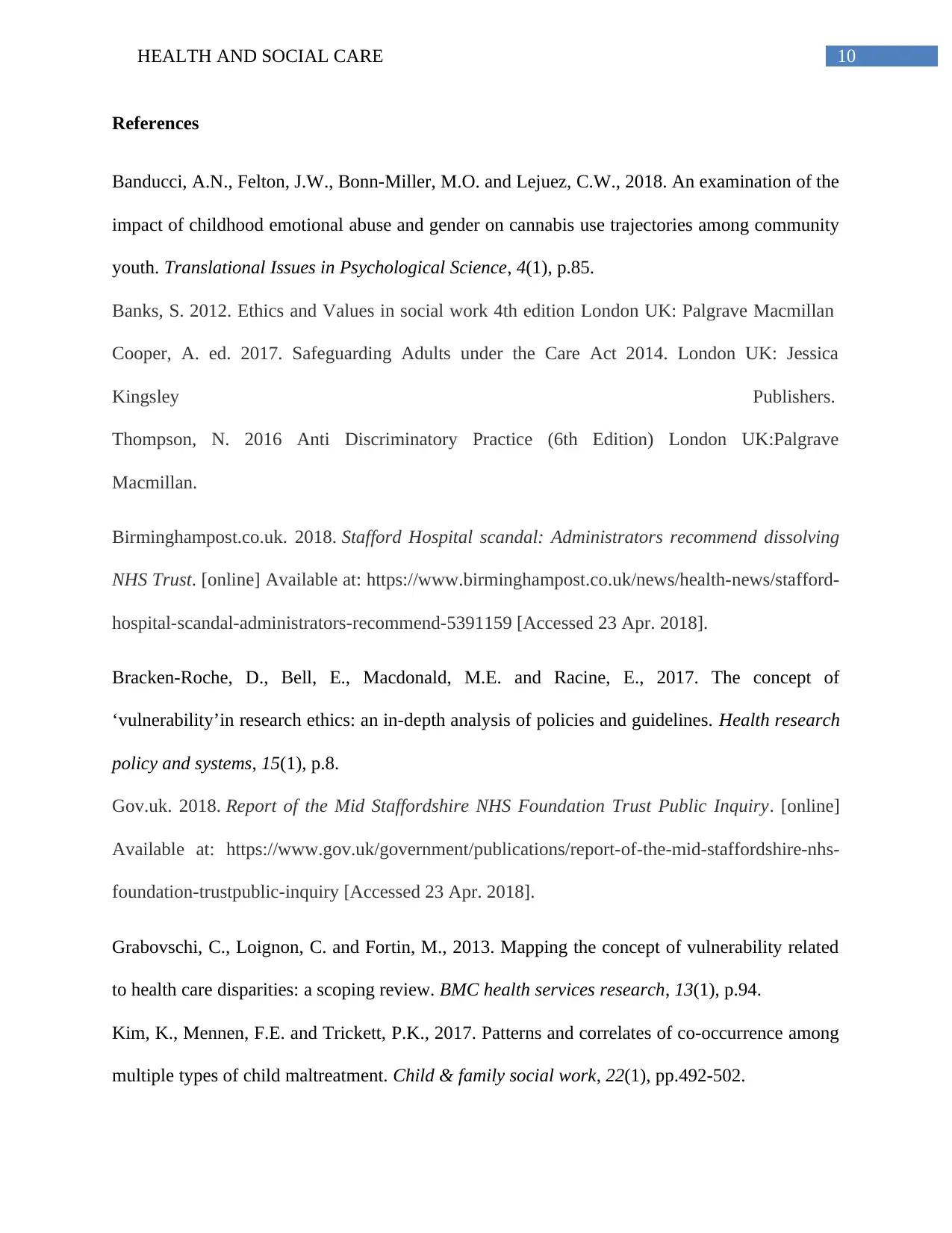
10HEALTH AND SOCIAL CARE
References
Banducci, A.N., Felton, J.W., Bonn-Miller, M.O. and Lejuez, C.W., 2018. An examination of the
impact of childhood emotional abuse and gender on cannabis use trajectories among community
youth. Translational Issues in Psychological Science, 4(1), p.85.
Banks, S. 2012. Ethics and Values in social work 4th edition London UK: Palgrave Macmillan
Cooper, A. ed. 2017. Safeguarding Adults under the Care Act 2014. London UK: Jessica
Kingsley Publishers.
Thompson, N. 2016 Anti Discriminatory Practice (6th Edition) London UK:Palgrave
Macmillan.
Birminghampost.co.uk. 2018. Stafford Hospital scandal: Administrators recommend dissolving
NHS Trust. [online] Available at: https://www.birminghampost.co.uk/news/health-news/stafford-
hospital-scandal-administrators-recommend-5391159 [Accessed 23 Apr. 2018].
Bracken-Roche, D., Bell, E., Macdonald, M.E. and Racine, E., 2017. The concept of
‘vulnerability’in research ethics: an in-depth analysis of policies and guidelines. Health research
policy and systems, 15(1), p.8.
Gov.uk. 2018. Report of the Mid Staffordshire NHS Foundation Trust Public Inquiry. [online]
Available at: https://www.gov.uk/government/publications/report-of-the-mid-staffordshire-nhs-
foundation-trustpublic-inquiry [Accessed 23 Apr. 2018].
Grabovschi, C., Loignon, C. and Fortin, M., 2013. Mapping the concept of vulnerability related
to health care disparities: a scoping review. BMC health services research, 13(1), p.94.
Kim, K., Mennen, F.E. and Trickett, P.K., 2017. Patterns and correlates of co‐occurrence among
multiple types of child maltreatment. Child & family social work, 22(1), pp.492-502.
References
Banducci, A.N., Felton, J.W., Bonn-Miller, M.O. and Lejuez, C.W., 2018. An examination of the
impact of childhood emotional abuse and gender on cannabis use trajectories among community
youth. Translational Issues in Psychological Science, 4(1), p.85.
Banks, S. 2012. Ethics and Values in social work 4th edition London UK: Palgrave Macmillan
Cooper, A. ed. 2017. Safeguarding Adults under the Care Act 2014. London UK: Jessica
Kingsley Publishers.
Thompson, N. 2016 Anti Discriminatory Practice (6th Edition) London UK:Palgrave
Macmillan.
Birminghampost.co.uk. 2018. Stafford Hospital scandal: Administrators recommend dissolving
NHS Trust. [online] Available at: https://www.birminghampost.co.uk/news/health-news/stafford-
hospital-scandal-administrators-recommend-5391159 [Accessed 23 Apr. 2018].
Bracken-Roche, D., Bell, E., Macdonald, M.E. and Racine, E., 2017. The concept of
‘vulnerability’in research ethics: an in-depth analysis of policies and guidelines. Health research
policy and systems, 15(1), p.8.
Gov.uk. 2018. Report of the Mid Staffordshire NHS Foundation Trust Public Inquiry. [online]
Available at: https://www.gov.uk/government/publications/report-of-the-mid-staffordshire-nhs-
foundation-trustpublic-inquiry [Accessed 23 Apr. 2018].
Grabovschi, C., Loignon, C. and Fortin, M., 2013. Mapping the concept of vulnerability related
to health care disparities: a scoping review. BMC health services research, 13(1), p.94.
Kim, K., Mennen, F.E. and Trickett, P.K., 2017. Patterns and correlates of co‐occurrence among
multiple types of child maltreatment. Child & family social work, 22(1), pp.492-502.
Paraphrase This Document
Need a fresh take? Get an instant paraphrase of this document with our AI Paraphraser
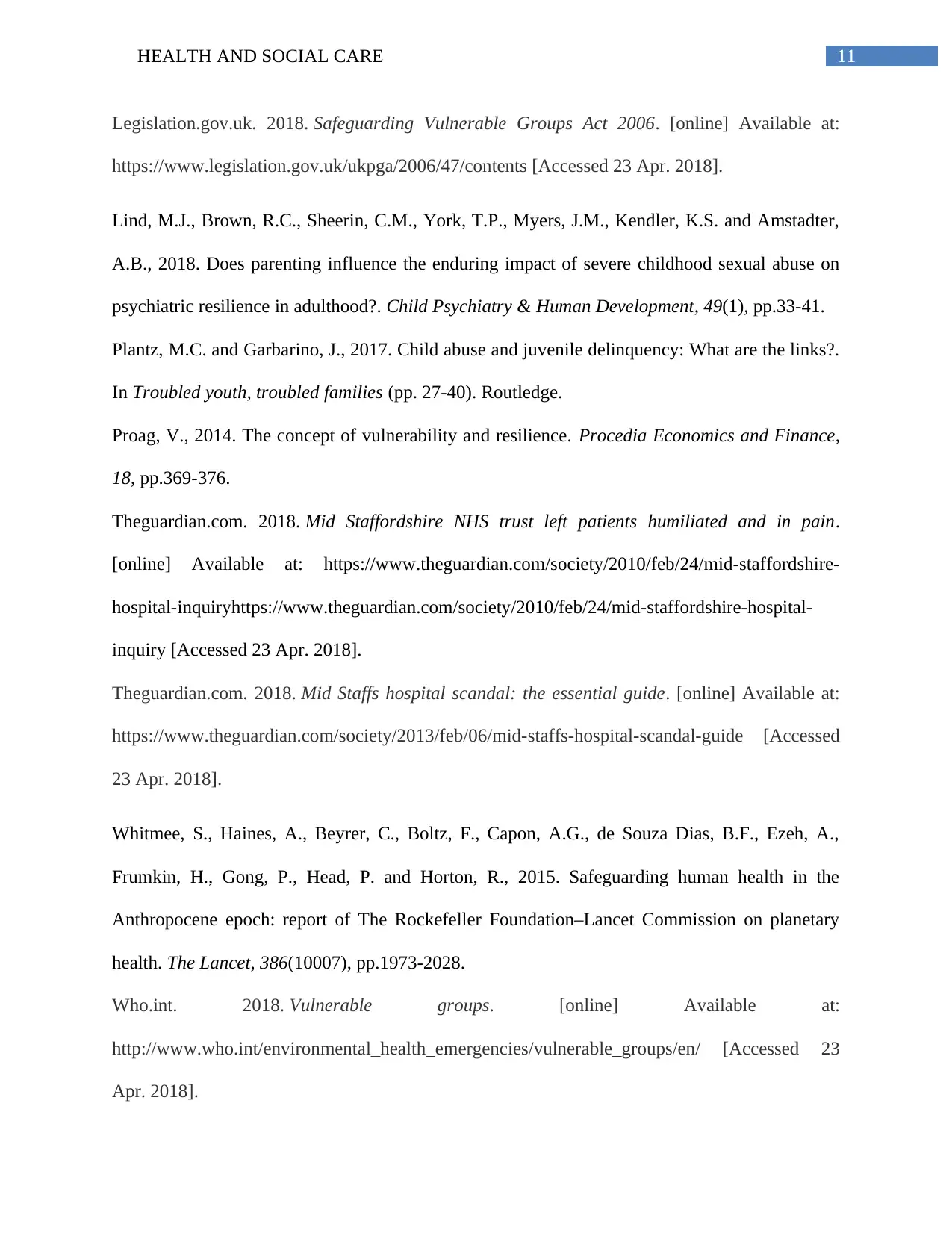
11HEALTH AND SOCIAL CARE
Legislation.gov.uk. 2018. Safeguarding Vulnerable Groups Act 2006. [online] Available at:
https://www.legislation.gov.uk/ukpga/2006/47/contents [Accessed 23 Apr. 2018].
Lind, M.J., Brown, R.C., Sheerin, C.M., York, T.P., Myers, J.M., Kendler, K.S. and Amstadter,
A.B., 2018. Does parenting influence the enduring impact of severe childhood sexual abuse on
psychiatric resilience in adulthood?. Child Psychiatry & Human Development, 49(1), pp.33-41.
Plantz, M.C. and Garbarino, J., 2017. Child abuse and juvenile delinquency: What are the links?.
In Troubled youth, troubled families (pp. 27-40). Routledge.
Proag, V., 2014. The concept of vulnerability and resilience. Procedia Economics and Finance,
18, pp.369-376.
Theguardian.com. 2018. Mid Staffordshire NHS trust left patients humiliated and in pain.
[online] Available at: https://www.theguardian.com/society/2010/feb/24/mid-staffordshire-
hospital-inquiryhttps://www.theguardian.com/society/2010/feb/24/mid-staffordshire-hospital-
inquiry [Accessed 23 Apr. 2018].
Theguardian.com. 2018. Mid Staffs hospital scandal: the essential guide. [online] Available at:
https://www.theguardian.com/society/2013/feb/06/mid-staffs-hospital-scandal-guide [Accessed
23 Apr. 2018].
Whitmee, S., Haines, A., Beyrer, C., Boltz, F., Capon, A.G., de Souza Dias, B.F., Ezeh, A.,
Frumkin, H., Gong, P., Head, P. and Horton, R., 2015. Safeguarding human health in the
Anthropocene epoch: report of The Rockefeller Foundation–Lancet Commission on planetary
health. The Lancet, 386(10007), pp.1973-2028.
Who.int. 2018. Vulnerable groups. [online] Available at:
http://www.who.int/environmental_health_emergencies/vulnerable_groups/en/ [Accessed 23
Apr. 2018].
Legislation.gov.uk. 2018. Safeguarding Vulnerable Groups Act 2006. [online] Available at:
https://www.legislation.gov.uk/ukpga/2006/47/contents [Accessed 23 Apr. 2018].
Lind, M.J., Brown, R.C., Sheerin, C.M., York, T.P., Myers, J.M., Kendler, K.S. and Amstadter,
A.B., 2018. Does parenting influence the enduring impact of severe childhood sexual abuse on
psychiatric resilience in adulthood?. Child Psychiatry & Human Development, 49(1), pp.33-41.
Plantz, M.C. and Garbarino, J., 2017. Child abuse and juvenile delinquency: What are the links?.
In Troubled youth, troubled families (pp. 27-40). Routledge.
Proag, V., 2014. The concept of vulnerability and resilience. Procedia Economics and Finance,
18, pp.369-376.
Theguardian.com. 2018. Mid Staffordshire NHS trust left patients humiliated and in pain.
[online] Available at: https://www.theguardian.com/society/2010/feb/24/mid-staffordshire-
hospital-inquiryhttps://www.theguardian.com/society/2010/feb/24/mid-staffordshire-hospital-
inquiry [Accessed 23 Apr. 2018].
Theguardian.com. 2018. Mid Staffs hospital scandal: the essential guide. [online] Available at:
https://www.theguardian.com/society/2013/feb/06/mid-staffs-hospital-scandal-guide [Accessed
23 Apr. 2018].
Whitmee, S., Haines, A., Beyrer, C., Boltz, F., Capon, A.G., de Souza Dias, B.F., Ezeh, A.,
Frumkin, H., Gong, P., Head, P. and Horton, R., 2015. Safeguarding human health in the
Anthropocene epoch: report of The Rockefeller Foundation–Lancet Commission on planetary
health. The Lancet, 386(10007), pp.1973-2028.
Who.int. 2018. Vulnerable groups. [online] Available at:
http://www.who.int/environmental_health_emergencies/vulnerable_groups/en/ [Accessed 23
Apr. 2018].
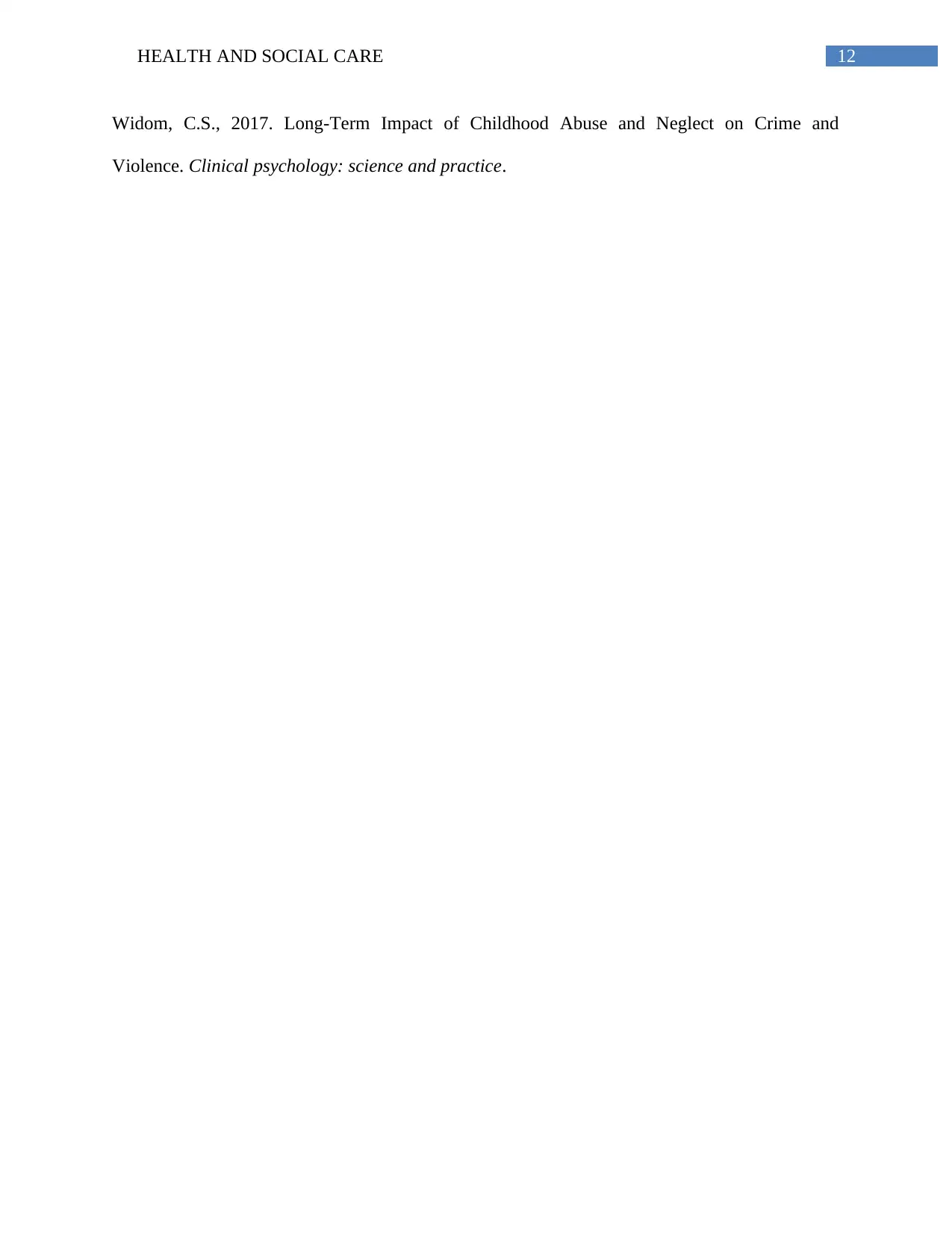
12HEALTH AND SOCIAL CARE
Widom, C.S., 2017. Long‐Term Impact of Childhood Abuse and Neglect on Crime and
Violence. Clinical psychology: science and practice.
Widom, C.S., 2017. Long‐Term Impact of Childhood Abuse and Neglect on Crime and
Violence. Clinical psychology: science and practice.
⊘ This is a preview!⊘
Do you want full access?
Subscribe today to unlock all pages.

Trusted by 1+ million students worldwide
1 out of 12
Related Documents
Your All-in-One AI-Powered Toolkit for Academic Success.
+13062052269
info@desklib.com
Available 24*7 on WhatsApp / Email
![[object Object]](/_next/static/media/star-bottom.7253800d.svg)
Unlock your academic potential
Copyright © 2020–2026 A2Z Services. All Rights Reserved. Developed and managed by ZUCOL.





